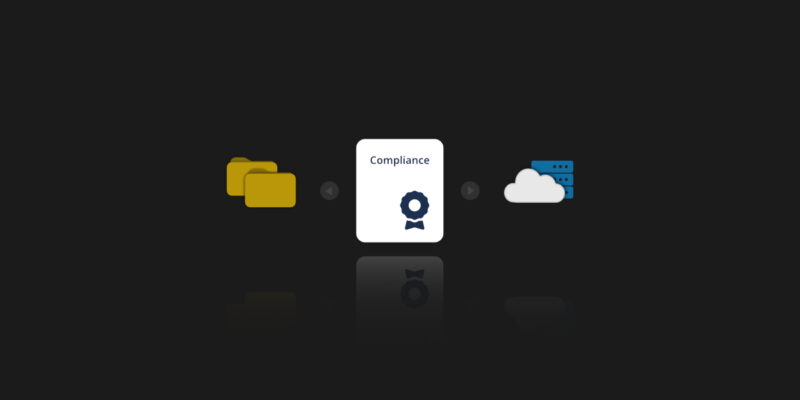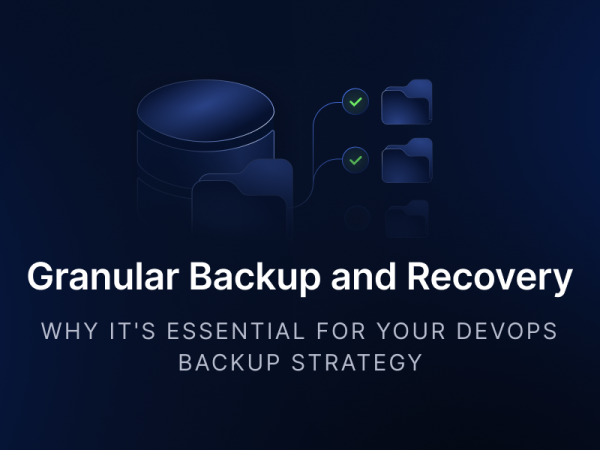
Repository And Metadata Backup, Disaster Recovery, And Compliance – Unbreakable Trio
Read the article and learn why Compliance, DevOps backup and Disaster Recovery go hand in hand. Try GitProtect.io for 14 days and see yourself what a compliant backup is.
Who said that there is no link between backup and compliance? Why should you have a compliant backup? What is more, why a Disaster Recovery is an inalienable part of a company’s compliance? What place here is given to Disaster Recovery? All those questions are better to consider when you deal with a company that works with any kind of data, especially critical ones.
Every day businesses face different challenges and they should find the solution as fast as possible, and in the majority of cases, when we speak about DevOps or IT societies, backup is crucial.
Compliance: why is it so desirable?
To figure out what compliance is and why you need a backup for compliance, it is better first to look at the reasons why some companies want to become GDPR-compliant or HIPAA-compliant, for example. There are many more certifications, among which ISO 27001, SOC 2 Type I, and SOC 2 Type 2 are the hardest nuts to obtain. There is a list of strict regulations your company should meet and fulfill to become compliant, and backup plays here not the last role, but let’s look at everything step-by-step.
So, compliance is a process of meeting and keeping up with the set of rules and regulations to provide business continuity, data security, and law fulfillment when a company deals with third-party organizations.
Why do companies want to become certification-compliant?
Being compliant with any of the security standards means a lot for a company that deals with critical data. It not only makes it more appealing to customers, but it also guarantees its trustworthiness. There are other “bonuses” a company gets when it becomes certification-compliant. Among them is that the company will:
- have such a trick in the sleeve as a business continuity plan,
- reduce such risks as security and privacy,
- guarantee that the company knows the appropriate ways to deal with security and cybersecurity challenges,
- guarantee security and privacy risk reduction.
What are the security components for compliance?
It is not an easy task to pass an audit for any well-known certification. Moreover, the criteria differ from certification to certification. Actually, your task is not only to pass the security audit, you will need to constantly prove your reliability and compliance with these regulations. Thus, we decided to list some of the most important requirements that your organization will need to keep up with:
Network Security
It means that all the infrastructure of your network is built in such a way that there is no threat to a network connection. No one can intercept it and get your data (so-called HTTPS protocol). Moreover, your data needs to be encrypted before it is sent to storage.
Multi-factor authentication
This prevention measure ensures that your account cannot be easily broken as you will need to provide different levels of authentication. You may create a relatively strong and reliable password, consisting of at least 16 characters and including lower and upper case letters, numbers, and signs, but it’s still not enough…
Two-factor authentication or multi-factor authentication is what your organization will need to adopt. it means that to access your data you will need not only a password but also some other piece of information that is known only to you to prove your identity. The most popular way is to add your telephone number and authenticate yourself with a password and the key phrase that is sent to your telephone number.
Stuff security awareness and training
That is crucial to inform and educate the employees on how to deal with information, which data should be kept, and which should be protected. You can create protocols to inform your team of a better understanding of the security requirements your organization has. Or, as an option, you can provide trainings and updates to be sure that all members of your team follow security best practices.
Read more about security best practices:
📌 GitHub Security Best Practices
📌 Atlassian Security Best Practices
Compliant backup
Probably the main requirement when it comes to compliance is backup. It guarantees that even in case of any failure (human mistake, bad actor’s interference, outage, or any other event of failure) all the data is going to be accessible and recoverable.
To guarantee that your DevOps tools are backed up and all the backup processes work as a clock, you should make sure that your backup option provides you with the possibility not only to set up a scheduled backups and automate the backup processes, but also keep your backups at multiple storage instances, encryption, ransomware protection, etc.
Data retention
Most SaaS service providers store users’ data by default from 30 to up to 365 days. However, it’s not enough when the organization is going through a security audit. For example, for ISO 27001 data retention requirements are 3 years. Thus, the possibility to keep data for a longer time is critical, and appropriate retention schemes are essential to become compliant.
Constant monitoring of security controls
It is also crucial to constantly monitor and check your security controls, as it can help to react fast and prevent security incidents should the need arise.
Strong Disaster Recovery Plan
Disaster Recovery is definitely one of the main requirements, as well. Why? Let’s see. What if one of your employees has made a mistake and deleted all the repository metadata? Or there is an infrastructure outage? It has happened many times, let’s remember the 2022 Atlassian outage when more than 700 Jira customers couldn’t access their Jira data for 14 days. Thus, your backup should foresee any disaster scenario, guaranteeing continuous workflow and eliminating data loss.
Communication with users
It doesn’t matter if we speak about security or everyday issues, communication is essential. All your users and customers should be aware of all the changes in your infrastructure. They should know how those changes can possibly influence them (small tip – it shouldn’t influence them at all), how your system works, and all the security and policy processes.
Risk assessment plan
You should try to do your best to foresee and forecast all the possible risks and impacts they can have on your business and, consequently, your customers. So, you should always have a plan on how to address all those risks and how to deal with them.
Backup & Compliance – Why is backup compliance a must?
We have just slightly mentioned that backup is one of the key features a company should perform to be seen as a compliant one. But here it’s worth saying not just backup, but a backup plan. Repository and metadata backup plans can greatly reduce your responsibility share in those regulations. Well, such requirements as proper communication with users and staff awareness are still on your shoulders, though, backup can decide the most critical ones.
What is the most important for the company? Yeap… It’s data, and what is more, its source code! How accessible and available it is even in case of trouble. Thus, once you decide to back up your data, you can easily restore all the information if a human mistake, outage, natural disaster, or malware attack takes place. So, backup for compliance is like water for fish.
There are no strict regulations for a compliant backup. It’s up to a company to decide how often they want to make copies of their most valuable data. It can be incremental copy every day, every week, and full copy every month ( the GFS backup scheme) or forever incremental. Everything depends on security audits the company wants to meet, regulations of the niche the organization operates within, and its own requirements and policy.
There is a golden rule to help your data always stay accessible and easily available – the 3-2-1 backup rule, according to which you have 3 copies kept in 2 different places, one of which is offsite. Following this rule, your data will always be at hand and within easy reach in case of a failure.
Moreover, backup is closely related to retention, which is also a must for a compliant backup plan. As long as you have a backup plan, you can keep a copy of your data for some time, 5, 10 years, or even forever if your backup provider permits unlimited retention. Of course, everything depends on the storage capabilities you have, though you can always correlate it with your backup plan.
Security should be mentioned here as well, as once you decide to backup your data, you can encrypt the information. For example, GitProtect.io permits you to encrypt your data both in-flight and at rest with your own encryption key, which means that you are the only one who can decrypt it.
Disaster Recovery & Compliance – What Disaster Recovery gives you?
Disaster Recovery, as well as backup greatly enlarges your possibilities to become compliant. Backup is useful only when all the most crucial data is recoverable. The main thing here is accessibility and availability.
Each company understands that access to the data must be fast and reliable. And the faster you can continue your everyday operations the better (Ideally, there should be no disruptions at all). For that reason, you should value your RPO and RTO metrics to understand how much time your company has for dealing with the disaster without affecting its business continuity.
Thus, your backup should foresee any disaster scenario. For example, if there is a service outage, you should have the possibility to restore your critical DevOps and operational data from any point in time to your local machine, or cross-overly to another Git hosting service platform (e.g. from GitLab to GitHub and Bitbucket, and conversely).
In the case your organization faces a human mistake or an accidental deletion, then you should have the opportunity to restore your data granularly to the same or a new account for instant access to your data for ontinuous forkflow.
You can find out more about Disaster Recovery strategy and how to build one in our related articles:
📌 GitHub Disaster Recovery Strategy
📌 GitLab Restore and Disaster Recovery Strategy
📌 Jira Disaster Recovery Strategy
📌 Bitbucket Disaster Recovery Strategy
Can GitProtect.io help to strengthen your compliance?
With GitProtect.io you can forget about any worries about your backup compliance at all. As GitProtect.io for GitHub, GitLab, Bitbucket and Jira is a comprehensive repository and metadata backup and recovery solution which helps any business to meet their compliance. GitProtect.io is SOC 2 Type I and Type II compliant and can guarantee data availability, confidentiality, processing integrity, and security.
Thus, summing up we can say that compliance, backup, and recovery are inseparable parts. Moreover, any certification compliance depends on a proper backup plan that ensures that data is available and secure.
[FREE TRIAL] Ensure compliant DevOps backup and recovery with a 14-day trial 🚀
[LIVE DEMO] Let’s discuss your needs and see a live product tour






